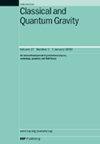Primordial gravitational wave backgrounds from phase transitions with next generation ground based detectors
IF 3.6
3区 物理与天体物理
Q2 ASTRONOMY & ASTROPHYSICS
引用次数: 0
Abstract
Third generation ground-based gravitational wave (GW) detectors, such as Einstein Telescope and Cosmic Explorer, will operate in the Hz frequency band, with a boost in sensitivity providing an unprecedented reach into primordial cosmology. Working concurrently with pulsar timing arrays in the nHz band, and LISA in the mHz band, these 3G detectors will be powerful probes of beyond the standard model particle physics on scales GeV. Here we focus on their ability to probe phase transitions (PTs) in the early Universe. We first overview the landscape of detectors across frequencies, discuss the relevance of astrophysical foregrounds, and provide convenient and up-to-date power-law integrated sensitivity curves for these detectors. We then present the constraints expected from GW observations on first order PTs and on topological defects (strings and domain walls), which may be formed when a symmetry is broken irrespective of the order of the phase transition. These constraints can then be applied to specific models leading to first order PTs and/or topological defects. In particular we discuss the implications for axion models, which solve the strong CP problem by introducing a spontaneously broken Peccei-Quinn (PQ) symmetry. For post-inflationary breaking, the PQ scale must lie in the GeV range, and so the signal from a first order PQ PT falls within reach of ground based 3G detectors. A scan in parameter space of signal-to-noise ratio in a representative model reveals their large potential to probe the nature of the PQ transition. Additionally, in heavy axion type models domain walls form, which can lead to a detectable GW background. We discuss their spectrum and summarise the expected constraints on these models from 3G detectors, together with SKA and LISA7.求助全文
约1分钟内获得全文
求助全文
来源期刊

Classical and Quantum Gravity
物理-天文与天体物理
CiteScore
7.00
自引率
8.60%
发文量
301
审稿时长
2-4 weeks
期刊介绍:
Classical and Quantum Gravity is an established journal for physicists, mathematicians and cosmologists in the fields of gravitation and the theory of spacetime. The journal is now the acknowledged world leader in classical relativity and all areas of quantum gravity.
 求助内容:
求助内容: 应助结果提醒方式:
应助结果提醒方式:


